on Oct 18, 2024
Innovative Leadership in Housing Affordability: Insights from HR&A Advisors’ Directors
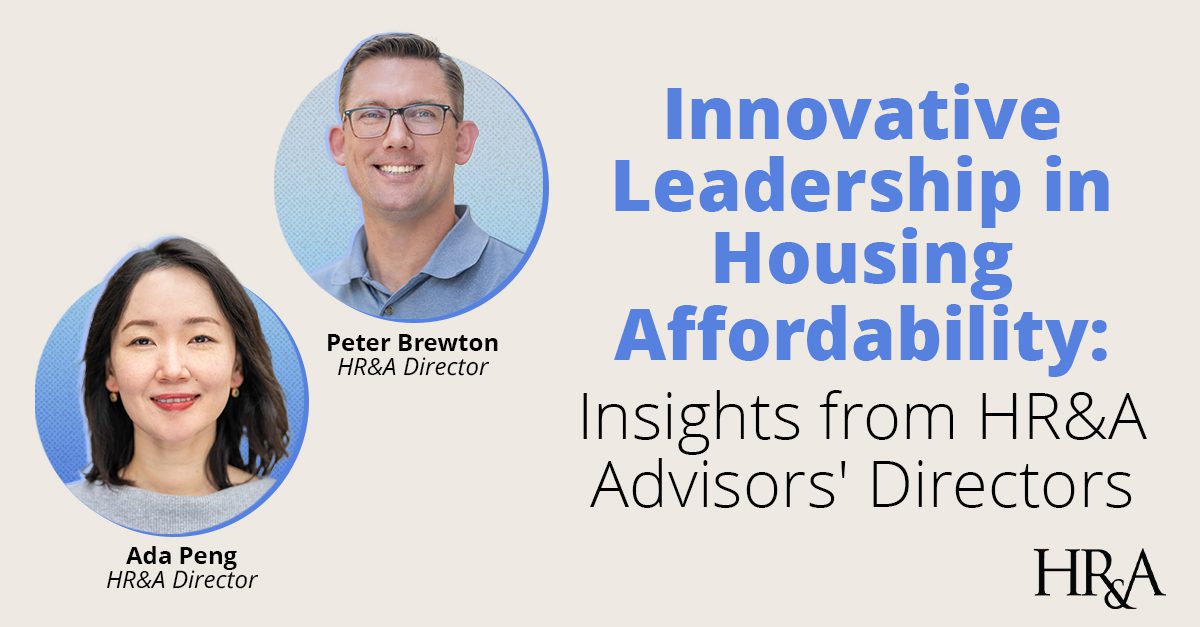
Innovative Leadership in Housing Affordability: Insights from HR&A Advisors’ Directors
At HR&A Advisors, addressing the complex challenges of housing affordability requires innovative approaches and dedicated leadership. Directors Ada Peng and Peter Brewton shared insights from working in housing affordability, emphasizing how leadership means navigating complexities, fostering teamwork, and creating lasting impact. If you’re passionate about making a difference tackling the housing crisis and are interested in a leadership role in our housing practice, we’re hiring!
What are some of the biggest challenges and rewards you encounter when tackling complex housing issues?
Ada: Housing projects often involve a wide array of stakeholders across different levels. As consultants, we strive to help our clients achieve specific housing outcomes like reducing housing burdens for renters or homeowners. However, moving from conceptual program design to real-world implementation requires a deep understanding of local contexts and figuring out where processes get stuck on the ground. At the same time, navigating the complexity successfully is also one of the most rewarding aspects of the work.
It’s incredibly fulfilling to connect with people directly involved in implementing policies and programs and support them to make the greatest impact. Housing isn’t just about numbers — it’s about how those numbers translate into real change in people’s lives. That transition, from measuring outcomes to understanding their impact on daily life, is what drives me.
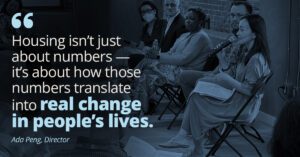
Peter: I completely agree. Housing and affordable housing, in particular, can sometimes feel overwhelming. The U.S. faces a shortage of millions of homes, and housing has become less affordable in almost every region where I’ve worked over the last decade. Even with massive projects like the $3.6 billion Amazon Housing Equity Fund, which HR&A helped design and execute and aims to create or preserve over 35,000 affordable homes, there is so much more work to do.
With that in mind, it’s essential to celebrate wins. Every time we launch a fund or close a deal, it’s a victory that took the efforts of many stakeholders. Those moments — whether it’s a ribbon cutting or a fund announcement — are always worth celebrating alongside incredible colleagues who pour their passion into making these projects a reality.
What innovative approaches are you exploring to address affordable housing challenges?
Ada: One approach we’ve been focusing on is naturally occurring affordable housing (NOAH) preservation strategies, especially in urban areas. We’re also exploring master leasing strategies to incentivize private landlords to accept housing vouchers, which can help maximize housing stock in a resource-constrained environment. Additionally, we’re working on innovative funding models that go beyond the traditional low-income housing tax credits (LIHTC) to meet growing demand.
Peter: Another area where we’re innovating is in building the capacity of public agencies to take a more active role in addressing affordable housing needs. We’re working with one housing authority in a major city to evaluate how they can increase the number of projects they own and manage. This aligns with our work across the country, where public agencies are seeking to have a larger role in housing development. Innovative housing projects require a mix of public policy expertise, understanding of deal economics, and risk management, which is where the diverse knowledge of HR&A’s housing practice is a real differentiator.
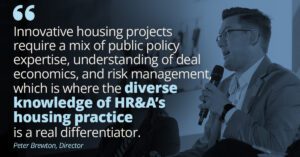
How has your leadership style fostered team growth and professional development in your teams?
Ada: For me, leadership is about mentorship and understanding the individual needs of team members. Everyone brings different levels of experience and perspectives to a project. I believe the best results come from nurturing individual growth while keeping a clear focus on delivering excellent results for our clients.
HR&A fosters a collaborative environment where you can grow your skills across different areas—whether it’s policy design, financial analysis, or stakeholder engagement. There’s always something new to learn, and the company encourages Directors to not only lead but also continuously build their expertise.
Peter: Affordable housing involves unique financing structures and concepts and helping junior staff, many of whom are new to affordable housing, navigate this world is really rewarding. I take a coaching approach, similar to how I coach my son’s soccer team. There’s nothing more satisfying than seeing our team execute what we’ve been trying to teach in a game. The same feeling applies when you notice an analyst have that “light bulb” moment when they grasp a concept or strategy. I learned by sitting side by side with mentors who taught me to always ask “why” and to approach every housing project with a deep understanding — not just plug-and-play knowledge. I try to pay that forward.
At HR&A, new Directors are given significant responsibility from the start. Directors are expected to bring skills and experience to the table, but also to drive their own learning. The projects we work on have real, tangible impact, and that’s the most exciting part — your decisions matter. For me, the opportunity to take on more responsibility and approach projects with an entrepreneurial mindset has been the biggest driver of my professional development.
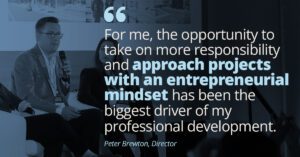
Can you share a specific project that successfully improved housing affordability for a community?
Peter: One project that stands out is Wake County’s affordable housing development program, which I was involved with early in my HR&A career. Back in 2016, HR&A conducted a housing needs assessment for Wake County and developed its strategic housing plan, which identified the need for such a program to stimulate low-income housing tax credit production. The program made a significant impact, quadrupling the annual production of 4% low-income housing tax credit units in the county. It’s a prime example of how thoughtful planning and implementation can truly transform a community.
By 2022, when I joined HR&A, the county asked us to help administer that year’s round of projects. This was my introduction to HR&A’s full-spectrum housing practice, from theoretical planning to bringing deals to the Board of Commissioners for funding approval. The program has had significant impact, quadrupling the annual production of 4% low-income housing tax credit units in the county — just as we had projected. It’s a great example of how thoughtful planning and implementation can make a real difference in a community.
Ada: A great example is the California Dream for All program, which supports first-time homebuyers through a shared appreciation down payment assistance model. The State Treasurer’s office launched this statewide program in 2022, which was a first-of-its-kind for California, where housing needs and affordability vary drastically by region. The challenge was to design a program that could cater to local variances, while maximizing benefits for end users.
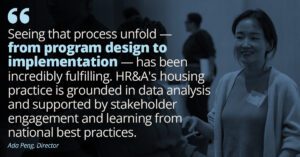
What was particularly rewarding was how quickly the program moved from concept to implementation. The state initially allocated $300 million, which helped over 2,000 first-time homebuyers, followed by another $220 million, reaching 1,700 first-generation homebuyers. Seeing that process unfold — from designing the program, talking with stakeholders, and learning from national best practices to project implementation and expanding first-generation homeownership — has been incredibly fulfilling.